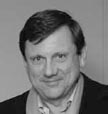 A seasoned hiker and skier who has visited most of the US National Parks, Keith Flaherty is no stranger to unfamiliar terrain. He entered college around the time of the molecular biology revolution in the early 1980s, and the new science entranced him. “It stuck with me as being an intriguing and fascinating level at which to try to understand human biology,” he says. In medical school he started to “think about patients and diseases in a molecular way.” That’s what attracted him to oncology, and, in particular, to finding cellular targets for curing the disease. Understanding cancer at that level was rather unexplored territory, and he has continued pushing into the blank spots on the map as the director of Development Therapeutics at Massachusetts General Hospital. “There is no area that I don’t find interesting…It’s what gets me out of bed in the morning,” he says. Flaherty discusses recent...
A seasoned hiker and skier who has visited most of the US National Parks, Keith Flaherty is no stranger to unfamiliar terrain. He entered college around the time of the molecular biology revolution in the early 1980s, and the new science entranced him. “It stuck with me as being an intriguing and fascinating level at which to try to understand human biology,” he says. In medical school he started to “think about patients and diseases in a molecular way.” That’s what attracted him to oncology, and, in particular, to finding cellular targets for curing the disease. Understanding cancer at that level was rather unexplored territory, and he has continued pushing into the blank spots on the map as the director of Development Therapeutics at Massachusetts General Hospital. “There is no area that I don’t find interesting…It’s what gets me out of bed in the morning,” he says. Flaherty discusses recent...
 The drive towards progress can often repress any desire to look back—but not for Giorgio Trinchieri, director of National Cancer Institute’s Cancer and Inflammation program. Inflammation’s relationship with cancer was first observed almost 2,000 years ago, and Trinchieri is interested in uncovering the science underpinning this relationship, which he explains in his article. Studying the genetics of implantation led him to immunology, and while at the Wistar Institute he discovered interleukin-12, which is naturally produced by certain immune cells and involved in the differentiation of T cells. “Scientific curiosity is really what motivates me most—and the satisfaction to break new ground,” he said in an e-mail. Trinchieri’s curiosity and historical concern is reflected in his interests, which include archaeology and cave paintings.
The drive towards progress can often repress any desire to look back—but not for Giorgio Trinchieri, director of National Cancer Institute’s Cancer and Inflammation program. Inflammation’s relationship with cancer was first observed almost 2,000 years ago, and Trinchieri is interested in uncovering the science underpinning this relationship, which he explains in his article. Studying the genetics of implantation led him to immunology, and while at the Wistar Institute he discovered interleukin-12, which is naturally produced by certain immune cells and involved in the differentiation of T cells. “Scientific curiosity is really what motivates me most—and the satisfaction to break new ground,” he said in an e-mail. Trinchieri’s curiosity and historical concern is reflected in his interests, which include archaeology and cave paintings.

 The natural beauty of the south of France might seem a perfect place to raise a budding biologist, but that’s not how Bruno Goud got into science. “I wanted to study literature,” he says. But after some job advice from his parents, he shifted over to biology—and hasn’t looked back. After earning a PhD in immunology from the Institut Pasteur in Paris, Goud became fascinated by how molecules move in and out of cells and did a stint at Yale University before returning to work on cellular transport at the Institut Curie. In 2000 he met Patricia Bassereau, who is not only passionate about cell membranes, but also French literature. “I read lots more novels than physics” growing up, she says, but after getting through the “boring” parts of physics, she hit upon soft matter and was hooked. At the Institut Curie she realized that she could bring her physics knowledge to biology, even though “cooking experiments” in her kitchen were the closest to biology she had ever come. “Twenty-five years ago, if you had told me that I would be working with biologists and proteins, I would think you were crazy!” she says. Read about the results of Goud and Bassereau’s decade-long collaborative study of intracellular membrane transfer.
The natural beauty of the south of France might seem a perfect place to raise a budding biologist, but that’s not how Bruno Goud got into science. “I wanted to study literature,” he says. But after some job advice from his parents, he shifted over to biology—and hasn’t looked back. After earning a PhD in immunology from the Institut Pasteur in Paris, Goud became fascinated by how molecules move in and out of cells and did a stint at Yale University before returning to work on cellular transport at the Institut Curie. In 2000 he met Patricia Bassereau, who is not only passionate about cell membranes, but also French literature. “I read lots more novels than physics” growing up, she says, but after getting through the “boring” parts of physics, she hit upon soft matter and was hooked. At the Institut Curie she realized that she could bring her physics knowledge to biology, even though “cooking experiments” in her kitchen were the closest to biology she had ever come. “Twenty-five years ago, if you had told me that I would be working with biologists and proteins, I would think you were crazy!” she says. Read about the results of Goud and Bassereau’s decade-long collaborative study of intracellular membrane transfer.